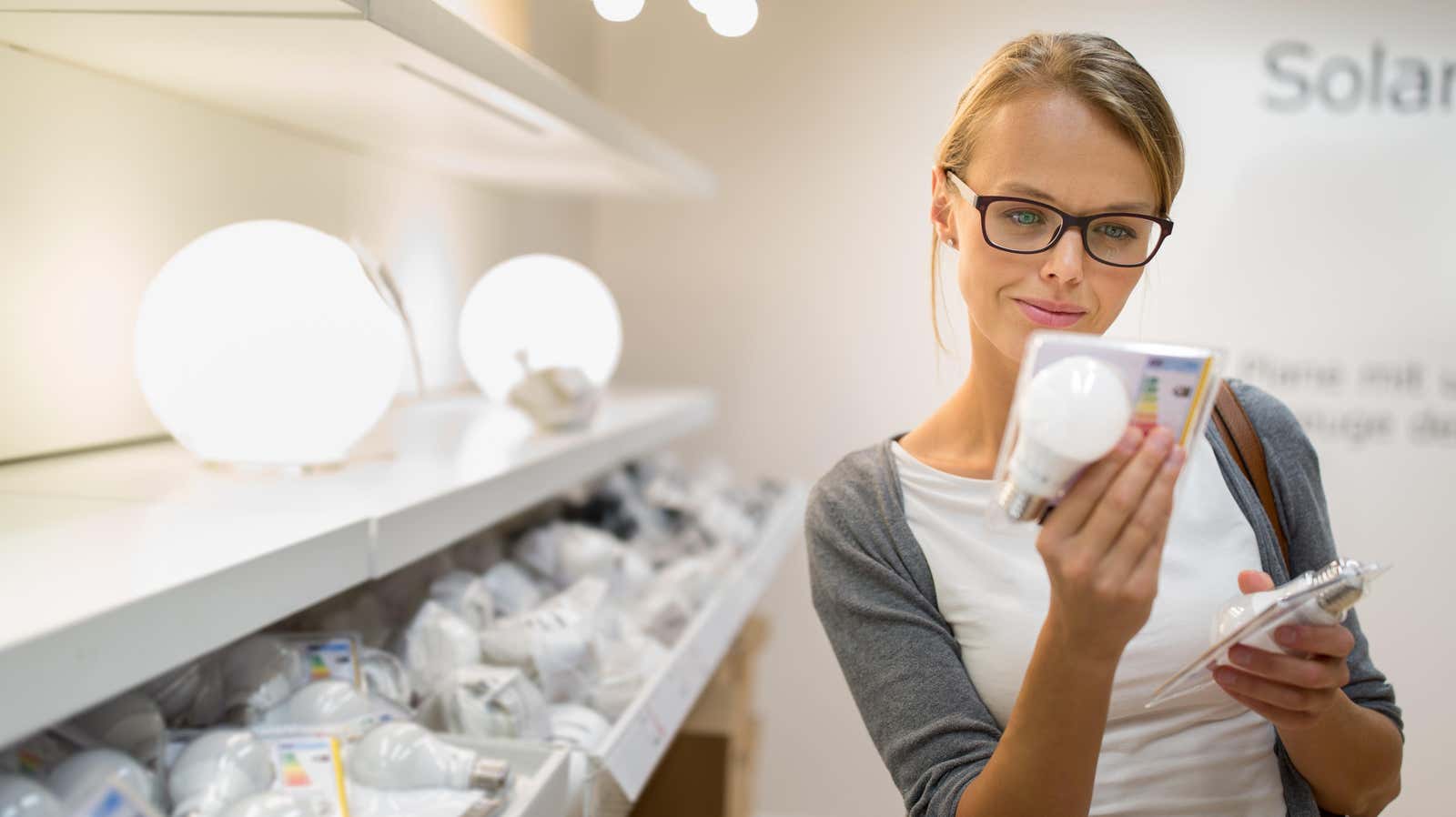How to Finally Stop Buying the Wrong Light Bulbs

If you’re of a certain age (i.e. old), you know that buying light bulbs used to be a relatively simple process: you marked the wattage you needed and bought more of the same. A 40-watt lamp gave a dimmer light than a 100-watt one. Easily! Of course, there have always been more exotic bulbs — halogen bulbs for that weird floor lamp you accidentally bought after college, those tiny bulbs in kitchen appliances that you swore to replace for years before finally just replacing the fixture itself because it was easier. — but for the basic task of lighting up the rooms in your home, it was a fairly straightforward process.
Today, everything is much more complicated. As usual, this is because technology has advanced. Not only are light bulbs more energy efficient and durable, but they also offer a wider range of brightness, warmth, and aesthetics. This has made it possible to fine-tune the lighting in your home, but it also means that buying light bulbs has become quite a challenge. Even the light bulb section of your local supermarket is now brimming with what seems like exotic choices, and the old-fashioned watt system no longer makes as much sense as it used to.
Good news? It’s still a pretty simple process to choose the right light bulb for the right purpose. Here’s everything you need to know to understand modern light bulbs.
Light bulb installation
The fitting is how your bulb fits into the socket. The most common remains the old-fashioned Edison screw, because the world is full of obsolete fixtures that use this fitting. Edison screws come in different sizes: your standard bulb uses E26, while smaller bulbs designed for chandeliers and the like use E12. There are also E11 and E17 fittings, but they tend to be much more specialized so you won’t come across them often.
Another fitting that you often come across is the G or GU fitting, which looks like two small pins. This fitting is commonly used with halogen bulbs and involves inserting pins into two holes and twisting until they lock into place. There are G-type fittings in different sizes (G4, G9 and GU10 are common).
There are many other fittings in the light bulb universe, but you won’t encounter most of them on a regular basis.
light bulb label
Like so much else in our consumer paradise, almost all the information you need is right there on the label. Look at any light bulb box and you will see a label like this:
These “lighting facts” tell you three key things: watts, lumens, and color temperature.
- Lumens: Lumens is a unit of measurement for brightness. When you have more lumens, you have more light – an old-school 100-watt incandescent bulb produced 1,600 lumens. If you want your room to be lit like you’re escaping from prison, you need as many lumens as possible. If you want a nightlight to guide you to the bathroom at 2am, you need a much lower light output.
- Watts: This used to be useful for determining the brightness of your light bulb, but today it’s mostly useful to see how much energy your light bulb needs to produce light. For example, an old school incandescent light bulb required 75 watts of power to produce 1,100 lumens of light. A modern LED lamp requires only 13 watts.
- Temperature: All light has a Kelvin temperature , ranging from warm to cold. Warmer light is yellow, colder light is white or blue. Choosing the temperature of your light is crucial: Do you need a cozy reading nook? Go warm. Do you need your finished basement to feel connected to the outside world? Go harder. Of course, you have to tune in according to your preferences, but here is a guide:
Bedroom: 2700-3000k, warm and soothing.
Bathrooms: 3000-4000 thousand, clean and fresh.
Living area: 2700-3000k, warm and relaxing
Kitchens: 3000-4000k, clean and bright
Offices and basements: 3500-5000K, cool and light
Lamp type
Almost all light bulbs you buy these days will be either LED or halogen. You can still find and buy old fashioned incandescent bulbs but they are getting harder to find and you don’t really want to buy them as they are incredibly energy efficient and short lived making them an expensive and wasteful choice. . Compact fluorescent lamps (CFLs) (those that have the appearance of “twisted” glass) were among the first high-efficiency lamps on the market, but they cannot compete with LEDs in terms of durability and power consumption, so they are quickly disappearing.
As a result, if you buy a light bulb with a standard Edison screw connection, you need an LED. LEDs have quickly taken over the market and chances are you can find an LED in any variety or style you need. The only thing to consider, aside from lumens, wattage and Kelvin temperature, is whether the LED will go into an enclosed fixture like the ones you usually see on ceilings. If your bulbs are going to live in some kind of glass enclosure, you need bulbs with a protection class. This is due to the fact that LEDs, while emitting much less heat than classic incandescent lamps, still emit some heat. When this heat is trapped inside the case, the LEDs wear out much faster.
One last note about dimmers. Many dimmers have been designed specifically to work with incandescent lamps and may not work well (or not at all) with dimmable LEDs. If you find this to be the case, you need to replace the dimmer with a modern version.
Light bulbs have become more complex, but with that complication comes the ability to customize our life experience, which is quite a powerful thing. All you need are a few important pieces of information and you are ready to go (to the lighting store).